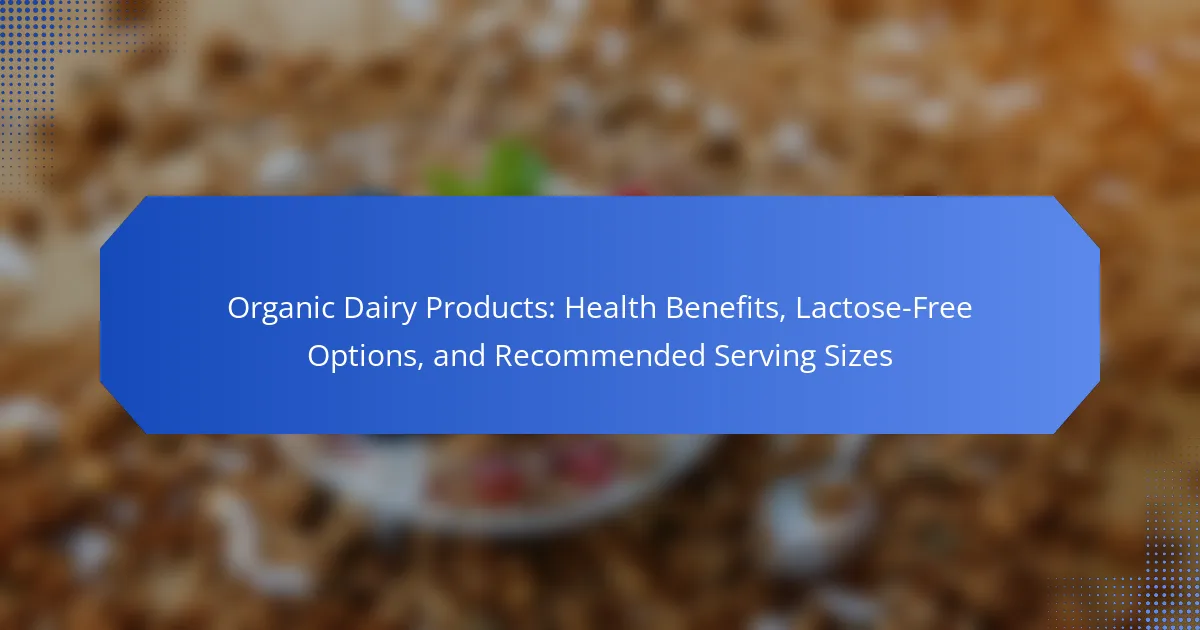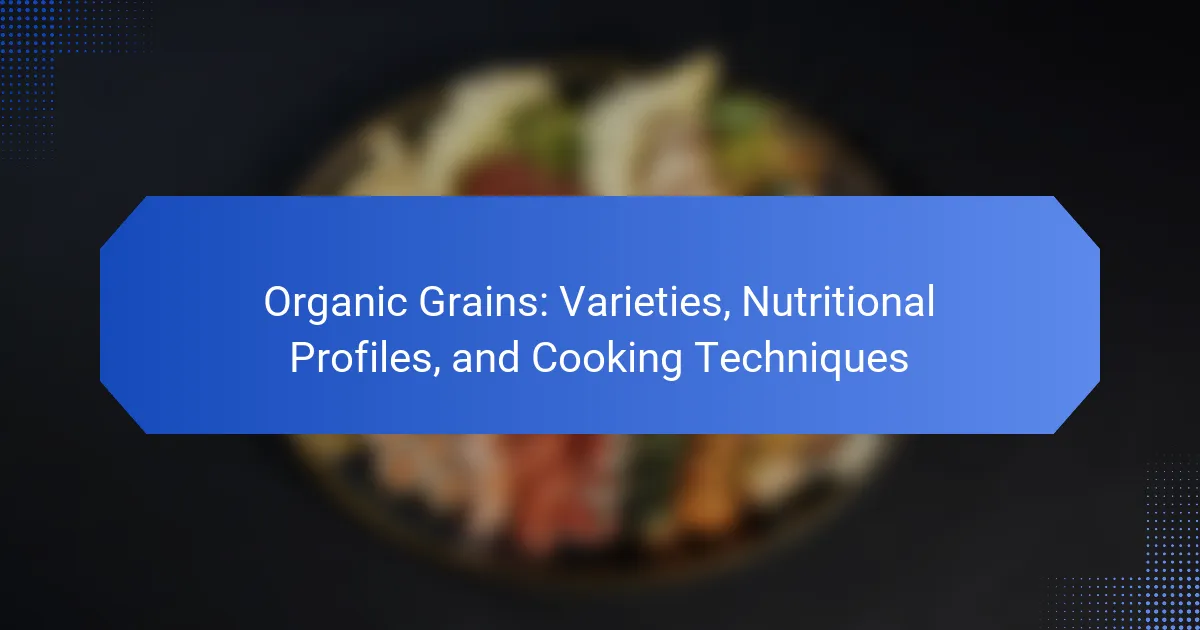Organic breads are made from ingredients cultivated without synthetic pesticides or fertilizers, primarily using organic grains such as wheat or rye. These breads adhere to strict agricultural standards, ensuring they are non-GMO and sustainably sourced. Research indicates that organic breads may offer higher nutrient levels, particularly antioxidants. The article will cover the essential components of organic bread, including organic flour, water, salt, and yeast, as well as additional ingredients like seeds and natural sweeteners. Best practices for baking organic bread will also be outlined, emphasizing the importance of high-quality ingredients and proper techniques for achieving optimal flavor and texture.

What are Organic Breads?
Organic breads are made from ingredients that are grown without synthetic pesticides or fertilizers. These breads typically use organic grains, such as wheat or rye, and may include organic seeds and grains. Organic bread production follows strict regulations set by agricultural standards. This ensures that the ingredients are non-GMO and sustainably sourced. Research shows that organic breads may contain higher levels of certain nutrients. For example, a study published in the Journal of Agricultural and Food Chemistry found that organic wheat has increased antioxidant levels compared to conventional wheat. Organic breads are often preferred for their natural flavor and texture.
How are Organic Breads different from conventional breads?
Organic breads differ from conventional breads primarily in their ingredients and production methods. Organic breads are made from ingredients that are grown without synthetic pesticides and fertilizers. In contrast, conventional breads may contain such additives. Organic grains are often non-GMO, while conventional grains can be genetically modified. The flour used in organic breads is typically milled without chemical processing. This results in a product that is more natural and often perceived as healthier. Additionally, organic bread production adheres to strict guidelines set by certification bodies. These guidelines ensure that the bread is free from artificial preservatives and additives. Studies indicate that organic bread can have higher nutrient levels compared to its conventional counterparts.
What ingredients define Organic Breads?
Organic breads are defined by the use of certified organic ingredients. These ingredients typically include organic flour, which is made from wheat grown without synthetic pesticides or fertilizers. Water is another essential ingredient, often sourced from clean, natural sources. Organic yeast is used for fermentation, ensuring no artificial additives are present. Additionally, organic salt is included for flavor, sourced from natural deposits. Some organic breads may also contain organic seeds or grains, such as flaxseed or sunflower seeds, adding nutritional value. The use of these organic ingredients adheres to strict agricultural standards, promoting sustainability and health.
What certifications are required for bread to be labeled organic?
Bread must meet specific certifications to be labeled organic. The primary certification is the USDA Organic certification. This certification ensures that the bread is made from ingredients grown without synthetic fertilizers or pesticides. Additionally, the grains used must be certified organic. The bread must also adhere to strict processing standards. These standards prohibit artificial preservatives and colors. All ingredients in the bread must be verified organic. Compliance with these regulations is monitored through inspections. This ensures that consumers receive products that meet organic standards.
What types of Organic Breads are available?
Whole grain bread, sourdough bread, multigrain bread, and gluten-free organic bread are common types of organic breads available. Whole grain bread is made from whole wheat flour, retaining the bran and germ. Sourdough bread is fermented, giving it a distinct tangy flavor. Multigrain bread contains various grains and seeds, enhancing its nutritional profile. Gluten-free organic bread is specifically made for those with gluten intolerance, using alternative flours like almond or rice flour. Each type provides unique flavors and health benefits, appealing to diverse dietary preferences.
What are the different grain options used in Organic Breads?
Organic breads commonly use whole wheat, spelt, rye, oat, and barley grains. Whole wheat is a popular choice due to its high fiber content and nutritional benefits. Spelt offers a nutty flavor and is easier to digest than regular wheat. Rye is known for its dense texture and distinct taste, often used in traditional bread recipes. Oat adds a mild sweetness and is gluten-free when certified. Barley contributes a chewy texture and is rich in vitamins and minerals. These grains are favored for their health benefits and ability to enhance the flavor and texture of organic breads.
How does the process of making Organic Breads vary by type?
The process of making organic breads varies by type primarily in ingredient selection and fermentation methods. Whole grain breads use whole wheat flour, which requires longer fermentation for flavor development. Sourdough breads utilize a natural starter, leading to distinct tanginess and texture. Gluten-free organic breads often incorporate alternative flours like almond or rice flour, necessitating different binding agents such as xanthan gum. Rye breads typically include rye flour, which absorbs more water, affecting dough hydration levels. Each type requires specific kneading techniques and baking times to achieve optimal results. For example, sourdough needs a longer proofing period compared to standard yeast breads. These variations highlight the unique characteristics of each bread type, influencing flavor, texture, and nutritional profile.
What health benefits do Organic Breads provide?
Organic breads offer several health benefits. They are typically made from whole grains, which provide essential nutrients. Whole grains are rich in fiber, aiding digestion and promoting gut health. Organic breads also avoid synthetic pesticides and fertilizers, reducing chemical exposure. They often contain fewer additives and preservatives. This can lead to a more natural and wholesome product. Additionally, organic breads may have a lower glycemic index, helping to regulate blood sugar levels. Studies show that consuming whole grains can lower the risk of heart disease. Overall, organic breads contribute positively to a balanced diet.
How do the ingredients in Organic Breads contribute to nutrition?
Organic breads are made from whole, unrefined ingredients that enhance nutritional value. Whole grains provide essential nutrients like fiber, protein, and B vitamins. Fiber aids digestion and helps maintain healthy cholesterol levels. Additionally, organic grains are less likely to contain harmful pesticides, promoting overall health. Seeds and nuts in organic breads contribute healthy fats, antioxidants, and minerals like magnesium and zinc. These ingredients work together to create a balanced source of energy. The absence of artificial additives ensures that the nutritional integrity remains intact. Thus, organic breads are a wholesome choice for a nutritious diet.
What are the potential digestive benefits of consuming Organic Breads?
Organic breads can offer several potential digestive benefits. They often contain whole grains, which are rich in dietary fiber. Fiber aids in digestion by promoting regular bowel movements. It can also help prevent constipation. The fermentation process used in making organic breads can enhance nutrient absorption. This process may support a healthy gut microbiome. Additionally, organic breads typically avoid artificial additives. This can lead to fewer digestive disturbances for sensitive individuals. Overall, consuming organic breads may contribute positively to digestive health.

What are the key ingredients in Organic Breads?
Organic breads primarily consist of organic flour, water, salt, and yeast. Organic flour is made from grains that are grown without synthetic pesticides or fertilizers. Water acts as a vital solvent in the dough-making process. Salt enhances flavor and controls yeast activity. Yeast is responsible for fermentation, which helps the dough rise. Additional ingredients may include organic seeds, nuts, and natural sweeteners like honey or maple syrup. These ingredients contribute to the nutritional profile and flavor of the bread. Organic breads are often free from artificial additives and preservatives, ensuring a more natural product.
What types of flours are commonly used in Organic Breads?
Whole wheat flour, spelt flour, and rye flour are commonly used in organic breads. Whole wheat flour is made from the entire grain, providing higher fiber content. Spelt flour is an ancient grain known for its nutty flavor and easier digestibility. Rye flour contributes a dense texture and unique taste, often used in traditional breads. Other flours like oat flour and almond flour may also be included for gluten-free options. These flours are selected for their nutritional benefits and flavor profiles in organic baking.
How does whole grain flour impact the health benefits of Organic Breads?
Whole grain flour enhances the health benefits of organic breads significantly. It increases dietary fiber content, promoting better digestive health. Whole grains also provide essential nutrients like B vitamins, iron, and magnesium. Research indicates that consuming whole grains can lower the risk of heart disease. A study published in the American Journal of Clinical Nutrition found that whole grain intake is linked to reduced cholesterol levels. Furthermore, whole grain flour has a lower glycemic index compared to refined flour. This helps in better blood sugar control. Overall, incorporating whole grain flour into organic breads results in a more nutritious product.
What role do natural sweeteners play in Organic Breads?
Natural sweeteners enhance flavor and texture in organic breads. They provide a subtle sweetness that balances the bread’s ingredients. Common natural sweeteners include honey, maple syrup, and agave nectar. These sweeteners can also contribute to browning during baking. This browning improves the visual appeal and adds depth to the flavor. Additionally, natural sweeteners can retain moisture, extending the bread’s shelf life. They often contain nutrients and antioxidants, offering potential health benefits. Overall, they play a crucial role in both taste and quality of organic breads.
How do additives in Organic Breads differ from conventional breads?
Additives in organic breads differ from those in conventional breads primarily in their source and purpose. Organic breads use natural additives, such as vinegar and enzymes, which enhance flavor and texture. Conventional breads often contain synthetic additives, like preservatives and dough conditioners, to extend shelf life and improve consistency.
The use of organic additives aligns with regulations that prohibit artificial substances in organic products. For example, the USDA organic certification requires that any additives be derived from natural sources. This ensures that organic breads maintain a higher standard of ingredient integrity compared to conventional options.
Research shows that consumers prefer organic breads for their perceived health benefits and fewer chemicals. A study published in the Journal of Food Science highlights that organic breads typically contain lower levels of harmful additives. This difference in additive composition reflects broader trends towards health-conscious eating.
What natural preservatives are used in Organic Breads?
Natural preservatives used in organic breads include vinegar, salt, and essential oils. Vinegar helps to inhibit mold growth and extends shelf life. Salt acts as a preservative by drawing out moisture and preventing bacterial growth. Essential oils, such as rosemary or thyme, possess antimicrobial properties that can enhance preservation. These natural ingredients are preferred in organic baking to avoid synthetic additives. Studies show that these preservatives effectively maintain freshness without compromising the health standards of organic products.
How do organic leavening agents affect the baking process?
Organic leavening agents affect the baking process by producing carbon dioxide gas, which causes dough to rise. These agents include ingredients like yeast and baking powder. Yeast ferments sugars, releasing carbon dioxide and alcohol. This fermentation process contributes to the texture and flavor of the bread. Baking powder releases carbon dioxide when it reacts with moisture and heat. This reaction occurs quickly, providing a rapid rise to baked goods. The use of organic leavening agents can result in a more natural flavor profile. Studies show that organic breads often have improved nutritional value and digestibility.

What are the best practices for baking Organic Breads?
The best practices for baking organic breads include using high-quality organic ingredients and maintaining proper hydration levels. Start with organic flour, yeast, and water to ensure purity. Measure ingredients accurately for consistent results. Knead the dough thoroughly to develop gluten structure. Allow adequate fermentation time for flavor development. Preheat the oven to the right temperature to achieve optimal crust formation. Bake until the internal temperature reaches 190-210°F for doneness. Use steam in the oven to enhance crust texture. Following these practices leads to flavorful and nutritious organic bread.
How can you ensure the perfect rise in Organic Breads?
To ensure the perfect rise in organic breads, use the right ingredients and techniques. Start with high-quality organic flour that has sufficient protein content. The protein aids gluten development, which is crucial for structure and rise. Use fresh yeast or sourdough starter to ensure effective fermentation. Proper hydration is essential; aim for a dough hydration level between 60-75%. This moisture helps yeast activity and gluten formation.
Knead the dough adequately to develop gluten, which provides the necessary elasticity. Allow the dough to rise in a warm, draft-free environment. The ideal temperature for fermentation is around 75-80°F (24-27°C). This temperature range promotes yeast activity. Additionally, perform a second rise after shaping the dough. This step enhances the final texture and volume.
Baking at the right temperature is also critical. Preheat your oven to 450°F (232°C) for a good oven spring. Steam in the initial baking phase can help achieve a better rise by creating a moist environment. Following these guidelines will contribute to achieving a perfect rise in organic breads.
What techniques help maintain moisture in Organic Breads?
Techniques that help maintain moisture in organic breads include using high-hydration doughs and incorporating fats. High-hydration doughs contain a higher percentage of water, which results in a softer crumb. Fats, such as olive oil or butter, create a barrier that retains moisture during baking. Additionally, using ingredients like honey or molasses can enhance moisture retention due to their hygroscopic properties. Properly storing the bread in airtight containers or wrapping it in plastic helps prevent moisture loss. These methods ensure that organic breads remain fresh and moist for longer periods.
How do you achieve a crispy crust on Organic Breads?
To achieve a crispy crust on organic breads, bake at a high temperature with steam. High temperatures, typically around 450°F to 500°F, promote crust formation. Introducing steam in the oven helps create a moist environment, allowing the bread to expand before the crust sets. Use a baking stone or preheated cast iron pan to enhance heat retention. Scoring the dough before baking allows for controlled expansion and improves crust texture. These methods ensure a well-developed, crispy crust.
What common mistakes should be avoided when baking Organic Breads?
Common mistakes to avoid when baking organic breads include using improper flour types. All-purpose flour may not provide the desired texture. Instead, whole grain or specialty flours are recommended for better results. Another mistake is not measuring ingredients accurately. Inconsistent measurements can lead to poor dough consistency. Additionally, neglecting to proof yeast properly can result in bread that does not rise. Yeast should be activated according to package instructions. Over-kneading or under-kneading the dough can also affect the final product. Proper kneading develops gluten, which is essential for structure. Lastly, not allowing sufficient time for fermentation can hinder flavor development. Adequate fermentation time enhances the bread’s taste and texture.
How can improper ingredient measurements affect the outcome?
Improper ingredient measurements can significantly alter the outcome of baking organic breads. Accurate measurements ensure the right chemical reactions occur during baking. For instance, too much flour can lead to a dense texture. Conversely, too little flour may cause the bread to collapse. Similarly, incorrect amounts of yeast can affect rising time and overall volume. A study from the Journal of Food Science indicates that precise ingredient ratios are crucial for desired bread characteristics. Therefore, maintaining proper measurements is essential for achieving the intended flavor, texture, and structure in organic bread.
What are the signs of overproofing in Organic Breads?
Signs of overproofing in organic breads include excessive dough expansion and a weakened structure. The dough may become overly airy and collapse easily when shaped. Another indicator is the presence of large bubbles on the surface. The bread may also exhibit a sour smell due to fermentation byproducts. Additionally, if the dough feels sticky and difficult to handle, it may be overproofed. These signs indicate that the yeast has consumed most of the available sugars. Proper fermentation timing is crucial for achieving the desired bread texture and flavor.
What tips can enhance your Organic Bread baking experience?
Use high-quality organic ingredients for better flavor and nutrition. Freshly milled flour retains more nutrients and flavor. Incorporate natural leavening agents like sourdough starter for improved texture. Allow sufficient fermentation time to enhance flavor development. Maintain proper hydration levels for a moist crumb. Use a preheated baking stone to achieve a crispy crust. Experiment with different grains and seeds for unique flavors. Monitor baking temperature closely to prevent over-baking.
Organic breads are made from ingredients grown without synthetic pesticides or fertilizers, often using organic grains like wheat and rye. The article explores the differences between organic and conventional breads, detailing the key ingredients, certifications required for organic labeling, and various types of organic breads available. It highlights the health benefits of organic breads, including higher nutrient levels and digestive advantages, while also providing best practices for baking, tips for achieving optimal texture and flavor, and common mistakes to avoid. Overall, the content serves as a comprehensive guide to understanding organic breads, their benefits, and effective baking techniques.



